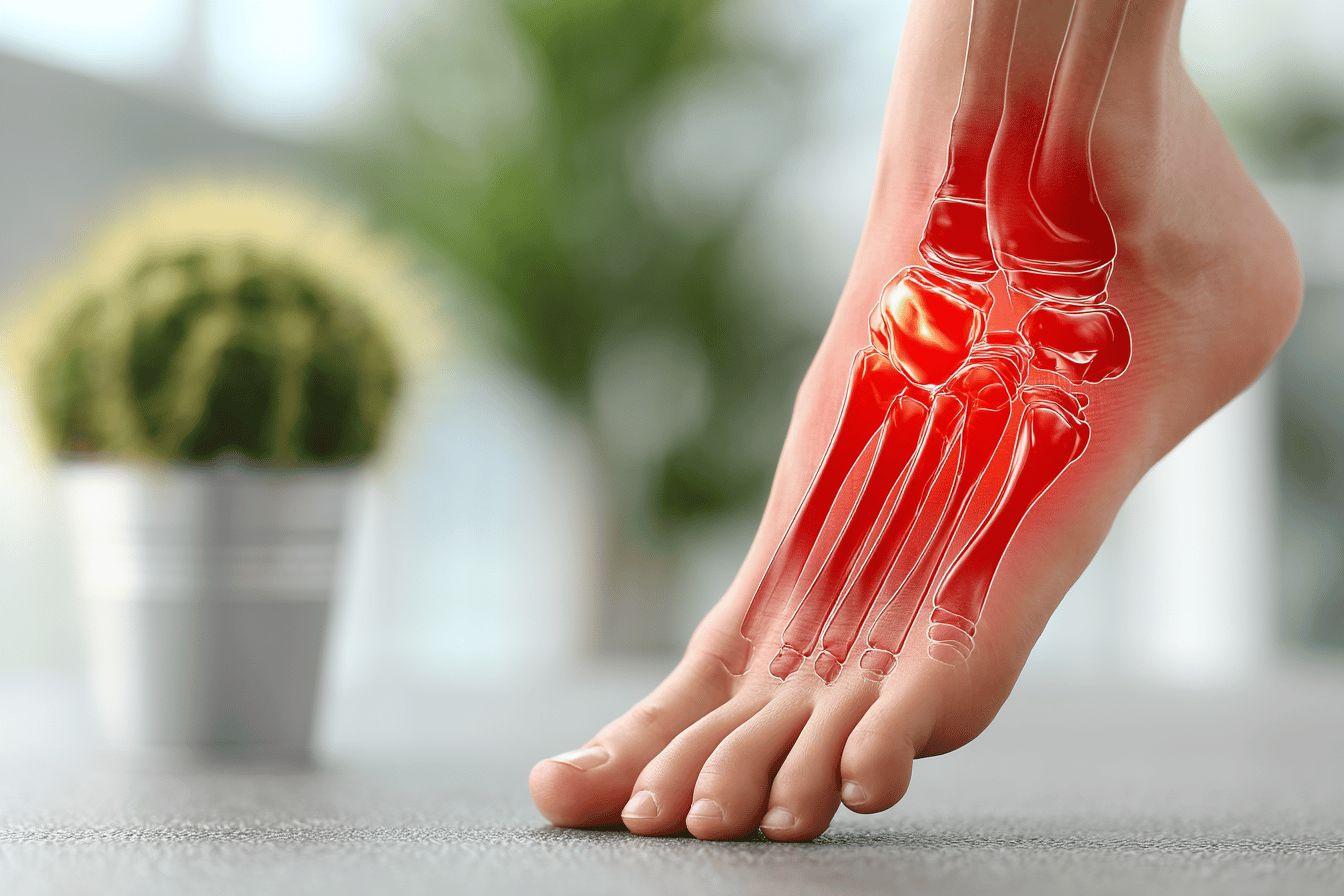Article at a glance
Foot neuropathy, a neurological condition affecting the lower extremities, significantly impacts quality of life.
- Characteristic symptoms: tingling, pins and needles, burning sensations, numbness, and stabbing pain, particularly at night.
- Main causes: diabetes (50% of cases), nutritional deficiencies, alcoholism, autoimmune diseases, and certain drug treatments.
- Effective treatments: a multifaceted approach combining medications (anticonvulsants, antidepressants), physiotherapy, and Regular foot inspection. Daily adjustments: appropriate physical activity, a balanced diet, and stress management techniques.
Neuropathy of the feet affects millions of people worldwide. This neurological condition can significantly affect quality of life by causing pain, numbness, and difficulty walking. Understanding its symptoms, causes, and available treatments can better manage this chronic condition, which primarily affects the lower extremities. Characteristic Symptoms of Peripheral Neuropathy of the Feet Peripheral neuropathy presents with a variety of symptoms that generally appear gradually. Patients often describe a sensation of tingling or pins and needles in the feet, particularly in the toes. These tingling in the foot are often the first warning signs.
Over time, symptoms may intensify and include:
- Burning or electric shock sensations
- Progressive numbness
- Hypersensitivity to touch (even a bed sheet can become painful)
- Thrashing pains, especially at night
- Muscle weakness in the feet
Progressing neuropathy can also cause balance and coordination problems. Some patients report a sensation of walking on cotton wool or not being able to properly feel the ground beneath their feet, increasing the risk of falls.
In advanced cases, numb toes may be accompanied by skin changes such as dry skin, discoloration, or ulcers that are difficult to heal, particularly in people with diabetes.

Main Causes and Risk Factors
Foot neuropathy results from damage to the peripheral nerves that transmit sensory information from the feet to the brain. Several factors can damage these nerve fibers and cause this condition:
Diabetes is the predominant cause, affecting up to 50% of long-term diabetics. Chronic hyperglycemia gradually damages the small vessels that nourish the nerves, leading to their deterioration.
Other common causes include:
- Nutritional deficiencies (vitamins B1, B6, B12)
- Excessive alcohol consumption
- Autoimmune diseases (rheumatoid arthritis, lupus)
- Infections (shingles, Lyme disease)
- Exposure to certain toxins or medications
Cancer treatments, particularly chemotherapy, can also cause chemotherapy-induced neuropathy. Certain medications such as statins or fluoroquinolone antibiotics also pose an increased risk.
Age is an independent risk factor, with people over 60 years of age being more likely to develop neuropathic symptoms due to the natural degeneration of nerve fibers with aging.
| Cause | Frequency | Characteristics |
|---|---|---|
| Diabetes | 40-50% | Symmetrical, distal-proximal progression |
| Alcoholism | 15-20% | Predominant sensory impairment |
| Vitamin Deficiencies | 10-15% | Often reversible with supplementation |
| Chemotherapy | 5-10% | Dose-dependent, sometimes reversible |
Effective Treatments and Relief Strategies
Management of foot neuropathy requires a multifaceted approach aimed at treating the underlying cause and relieving symptoms. In the case of diabetes, careful blood sugar control can slow the progression of nerve damage.
Medications are often the first line of treatment for neuropathic pain. Anticonvulsants such as pregabalin and gabapentin modify the transmission of pain signals. Tricyclic antidepressants and serotonin-norepinephrine reuptake inhibitors (SNRIs) also offer significant relief for many patients.
Complementary therapies play an important role in symptom management:
Physical therapy and specific exercises can improve muscle strength and balance. Acupuncture shows promising results in some patients, reducing the intensity of pain and tingling in the foot. Transcutaneous electrical nerve stimulation (TENS) provides temporary relief by blocking pain signals.
For daily care, regular foot inspection is crucial, especially for people with diabetes. Wearing proper shoes, using cushioning insoles, and maintaining good podiatric hygiene can prevent complications.
Nutritional supplements such as alpha-lipoic acid, vitamin B12, and acetyl-L-carnitine can complement medical treatment, although their effectiveness varies from person to person. Always consult a healthcare professional before starting any supplementation.
Daily Living with Foot Neuropathy
Adjusting lifestyle is an essential aspect of long-term neuropathy management. Regular, appropriate physical activity, such as swimming or stationary cycling, improves circulation and preserves muscle function without damaging the feet. Diet plays a crucial role in managing this condition. A balanced diet rich in antioxidants, B vitamins, and omega-3s contributes to nerve health. Reducing alcohol consumption and quitting smoking significantly improve microcirculation to the extremities. Stress management techniques such as meditation, adapted yoga, or deep breathing can reduce the perception of pain. Support groups, in person or online, provide a valuable forum for sharing with others facing similar challenges. In cases of severe neuropathy, assistive devices such as canes or walkers can improve mobility and prevent falls. For particularly refractory pain, more advanced options such as spinal cord stimulation may be considered after a comprehensive evaluation by specialists.
Foot neuropathy represents a complex medical challenge requiring a personalized approach. With appropriate, multidisciplinary care, the majority of patients are able to effectively manage their symptoms and maintain a satisfactory quality of life.





Leave a comment
This site is protected by hCaptcha and the hCaptcha Privacy Policy and Terms of Service apply.